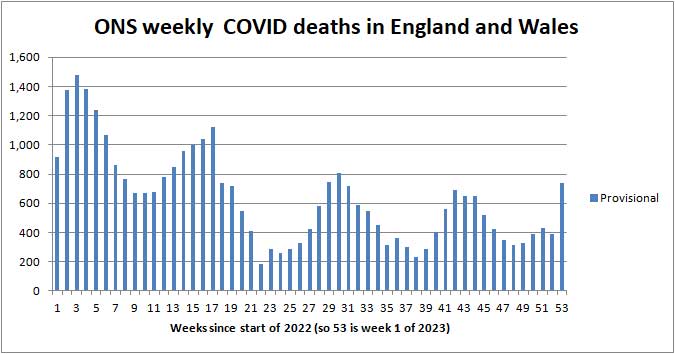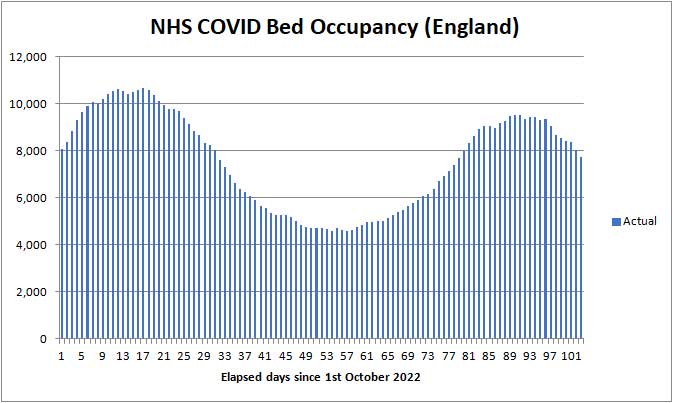
Angus and Rosemary's Miscellany
of Malvern - Other Resources
|
Coronavirus (COVID-19) epidemic weekly update for Malvern SeniorsNew cut down version Click to read our observations on politics and world events 22nd January 2023
New daily cases and hospital admissions falling PreambleFor nearly three years we have been keeping an eye on the published government figures and monitoring the media to asses the likely level of risk for Seniors in the Malvern Hills district and providing links to where further information could be found. For most people, COVID is no longer a critical threat to health so this a shortened version of our weekly update which will continue to be updated weekly, nominally with Sunday's date, for a few weeks more. ContentsSummaryIn the last week, NHS COVID bed occupancy and daily hospital admissions have continued to fall in England, while daily deaths remains 'acceptably' low. What happens if you get sick with COVIDIf you are feeling poorly there is now a fair chance it won't be COVID-19 but some other winter respiratory illness; 'bugs and lurgi' of the unknown variety have recently left friends feeling very poorly, sometimes for two to three weeks. If you have a stash of Lateral Flow Tests you could test yourself at home. However be aware that a negative test does not guarantee you don't have COVID. Whatever the virus best stay at home until you feel better, and wear a face mask to protect others if you do have to go out. Do not be surprised if you catch COVID because prevalence is still quite high and vaccination, while protecting from severe illness, is unlikely to prevent infection. The lucky may either show no symptoms or have a mild fever, sore throat, general aches and pains, and quickly get over it; while others could feel quite poorly and spend between two and five days in bed, with it taking five to ten days or so to recover. Some of those who have caught COVID report either getting easily tired or suffering from shortness of breath for some weeks afterwards; if so patients are advised to take it easy until fully recovered. A small number of patients report debilitating symptoms for months after so-called recovery. For example see Dez Medinger and Danny Altmann's book The Long COVID Handbook in bibliography. PrecautionsNowadays few people are taking precautions - for many months that has been a personal decision. A few people can still be seen wearing facemasks. Booster shotsAn Autumn booster shot was offered to all those aged 50+ years and patients designated Clinically Extremely Vulnerable, such as those with a severely weakened immune system. Now the epidemic is all but over we assume all those who wanted to be vaccinated have been. If not, we suggest you contact your GP. Vaccination SitesSection deleted; if necessary refer to 2022 archived blogs (see menu of archived pages).
|
| Date report published | Prevalence (England) | Ratio of people with COVID |
| 2nd December 2022 | 873,200 | 1:60 |
| 9th December 2022 | 941,700 | 1:60 |
| 16th December 2022 | 1,095,100 | 1:50 |
| 23rd December 2022 | 1,197,200 | 1:45 |
| 6th January 2023 | 2,463,000 | 1:20 |
| 13th January 2023 | 2,189,300 | 1:25 |
| 20th January 2023 | 1,461,900 | 1:40 |
Prevalence of COVID-19 in England estimated by ONS
Prevalence is estimated 1:25 in Wales; 1:30 in Scotland; and 1:25 in Northern Ireland.
Zoe Health Study
The ZOE Health Study estimates are shown in the following table.
| Date of screenshot | Prevalence (UK) | Estimated new infections per day |
| 1st December 2022 | 2,079,518 | 147,525 |
| 8th December 2022 | 2,156,915 | 173,889 |
| 15th December 2022 | 2,524,929 | 219,131 |
| 22nd December 2022 | 3,092,451 | 262,675 |
| 5th January 2023 | 3,293,888 | 216,645 |
| 12th January 2023 | 2,960,068 | 169,654 |
| 19th January 2023 | 2,159,096 | 94,762 |
Prevalence of COVID-19 in UK estimated by the Zoe Health Study
According to the more recent Zoe figures, estimated prevalence has fallen by 27% while daily cases have fallen by 44% during the last week, suggesting the Winter Wave peaked three weeks ago.
The downwards direction of travel is confirmed by Hospital bed occupancy dipping.
 Number
of deaths
Number
of deaths
Statistics on COVID deaths are published by Public Health England, The Office of National Statistics, and NHS England. These can't be directly compared as they cover different periods, but together the figures paint a picture of the direction of travel - which is that the death rate in real-time probably peaked two weeks ago, whereas the delayed ONS figures are still rising.
PHE figures
The Dashboard chart of COVID (28) deaths, following a positive test, by date of death shows that the 7 day average peaked in England at 164 deaths per day on 30th December before falling to 132 deaths per day on 9th January 2023 (add a further 4 deaths per day for Wales).
The Coronavirus Dashboard charts suggest 30th December marked the peak of Winter Wave deaths.
The PHE figures include people who die with COVID but not from it so are higher than the ONS numbers.
Click to view the UK government Coronavirus Dashboard
ONS figures
The Office of National Statistics (ONS) reports registered deaths in England and Wales where COVID-19 is mentioned somewhere on the death certificate. The ONS figures lag real time by 10 - 14 days due to the administrative delay in submitting and processing reports, and do not include Northern Ireland and Scotland.
Note: the figures include cases where COVID may have been a secondary cause of death.
Click for ONS data on deaths (Excel spreadsheet)
The ONS figures are broken down by Local Authority providing a glimpse of where deaths are occurring. The provisional cumulative total of COVID related deaths in Worcestershire reported by the ONS up to 6th January (week 1 of 2023) is shown below.
Note: the numbers are now derived from Table 1 of the ONS Death Registrations spreadsheet using the in-built filters. This gives the provisional total of deaths registered in any week, which can be distorted by delayed reporting, for example, due to public holidays.
Deaths by Welsh Health Boards are excluded to avoid duplication as these are totals of Local authorities.
Death occurrences by 'date of death' is the most accurate metric but takes longer to be confirmed.
| Districts of Worcs |
Deaths 2020 |
Deaths 2021 |
Deaths 2022 |
Deaths 2023 |
Week 1 | Population |
| Bromsgrove | 164 | 142 | 59 | 2 | 2 | 98,529 |
| Malvern Hills | 61 | 98 | 74 | 1 | 1 | 77,545 |
| Redditch | 108 | 109 | 47 | 2 | 2 | 85,317 |
| Worcester | 87 | 134 | 51 | 0 | 0 | 103,542 |
| Wychavon | 157 | 154 | 85 | 2 | 2 | 126,240 |
| Wyre Forest | 171 | 132 | 62 | 0 | 0 | 100,957 |
| TOTAL | 748 | 769 | 378 | 7 | 7 | 592,130 |
Provisional cumulative COVID-19 deaths in Worcestershire registered by ONS to 6th January 2023.
There was 1 death in a care home and 1 in hospital in Bromsgrove; 1 death in a care home in the Malvern Hills; 1 death in a care home and 1 in hospital in Redditch; and 2 deaths in hospital in Wychavon.
The general picture is of a continuing handful of deaths per week in Worcestershire.
In England and Wales 736 COVID-19 related deaths were reported in the week to 6th January, 344 more than the week before and a rise of 87%. Of these 129 were in care homes, 30 at home, 13 in a hospice, 561 in hospital and 3 elsewhere.
Note: it's unlikely deaths were actually as high as 736 in week 1. This figure probably includes registrations delayed by the Christmas and New Year holiday. As a rough guess deaths may have been about 650, and 500 the week before.

ONS provisional deaths 'by week reported' in England and Wales since the start of 2022 (so week 53 is week 1 of 2023)
The figures on the Coronavirus Dashboard of ONS deaths by date on the death certificate show ONS England deaths rose to 607 per week as of 23rd December (add 45 for Wales) with the curve suggesting a little higher to go.
In comparison averaged over recent years roughly 1,700 people die daily from all causes in the UK, so currently COVID deaths represent about 5% of all deaths.
Click for ONS Coronavirus (COVID-19) latest insights: Deaths
NHS England figures
Daily COVID hospital death figures in England have ranged randomly between 63 and 104 per day during January. Possibly the average is just beginning to drop.
NHS England figures for Worcestershire
The table below shows the latest COVID deaths in Worcestershire hospitals reported by NHS England on 19th January 2022.
| Worcestershire | Cumulative deaths | Past week |
| Acute hospitals | 1,228 | 5 |
| Care hospitals | 93 | 1 |
| TOTAL | 1,321 | 6 |
Excludes deaths in care homes, deaths at home and deaths in hospices.
Note: the increase is the difference between this week's cumulative total and that last reported.
Click for NHS COVID-19 total announced deaths
Look for COVID Total announced deaths file, then select tab Deaths by Trust.
Note: NHS say all deaths are recorded against the date of death rather than the date the deaths were announced. As from 1st July 2022 reporting has moved to publication once per week on a Thursday, rather than every weekday.
Risk of COVID-19 death by age band
NHS England provides an analysis of COVID-19 deaths in hospital in England and Wales by age band. Shown below is a snapshot of 2,898 recent deaths for the period 6th May 2022 to 6th July 2022 when most of these deaths will have been from the Omicron variants.
| Age band | Number of COVID deaths | % of deaths |
| 0 - 19 | 8 | 0.3 |
| 20 - 39 | 25 | 0.9 |
| 40 - 59 | 165 | 5.7 |
| 60 - 79 | 1,010 | 34.9 |
| 80+ | 1,692 | 58.4 |
Relative risk of COVID-19 death by age band May - July 2022
The main point to note is those aged 60+ still account for 93% of deaths despite young people being more likely to catch COVID-19.
The risk profile for Omicron appears to be the same as for Delta. Age is still the greatest risk factor; perhaps reflecting that older people have more health problems.
According to the Coronavirus Dashboard sex is an additional risk factor - males are roughly 50% more likely to die than women.
 Healthcare numbers
Healthcare numbers
The UK government Coronavirus Dashboard includes information about healthcare statistics and NHS bed occupancy.
| Hospital COVID cases (England) | Number | Last week |
| Patients currently in hospital | 6,299 | -1,444 |
| Patients on ventilation | 146 | -36 |
| Patients admitted daily | 587 | -221 |
Headline summary of patients in hospital reported on 19th January 2023
Note: 'Patients admitted daily' is the weekly total divided by 7. This number includes both patients admitted to hospital with COVID-19 from the community, and those diagnosed with COVID-19 in hospital.
Daily admissions had peaked at 992 on the 3rd January 2023.
See charts on the Coronavirus Dashboard and below.
Bed numbers by region in England
Tabulated figures for COVID bed occupancy in England can be found on the NHS England website providing another indicator of the prevalence of COVID.
Click for NHS England COVID-19 Hospital bed Activity statistics
Note: see the latest Daily Admissions and Beds spreadsheets, then look for all COVID beds.
| Region | 11th January 2023 | 18th January 2023 | 15th January 2021 |
| England | 7,743 | 6,299 | 33,362 |
| London | 1,340 | 1,079 | 7,811 |
| Midlands | 1,480 | 1,193 | 5,890 |
Comparison of All beds COVID data for England, London and Midlands
In the last week the number of COVID-19 General and Acute beds fell by 19% in England, 19% in London and 19% in the Midlands.
For comparison, the number of beds occupied during the peak of the epidemic in January 2021 is shown in red in the right hand column of the table.
The chart below shows how COVID bed occupancy peaked about two weeks ago.
Note: the peak in beds is usually one week delayed on the peak in daily admissions, and deaths roughly lag beds by a further week.

COVID bed occupancy in England from 1st October to 11th January 2023
 Worcestershire
hospital beds
Worcestershire
hospital beds
Between 10 January 2023 and 16 January 2023, 46 patients went into hospital with coronavirus. This shows a decrease of 15% compared to the previous 7 days. There were 76 patients in hospital with coronavirus on 18 January 2023, nine less than the week before; one on a ventilator.
Click for Summary of Malvern numbers on the Coronavirus dashboard
This link also reports deaths.
Deaths in Malvern Hills
Between 8 January 2023 and 14 January 2023, there have been 2 deaths within 28 days of a positive coronavirus test
Forecast for the week ahead
We expect COVID related deaths registered in England and Wales to level off at about 675 deaths per week in week 2 of 2023 to be reported by the ONS on 24th January.
In the county of Worcestershire, based on 46 new hospital cases last week and assuming the ratio of all deaths (including those in care homes and at home) to be 1:11 of admissions, then there should be no more than 4 COVID deaths per week towards the end of January 2023.
NHS COVID bed occupancy in England could drop by a further 20% next week.
Longer term outlook (up to the end of January 2023)
Given that COVID hospital bed occupancy peaked at 10,608 beds in England in October; has further peaked at 9,332 at the end of December and since fallen to 6,299 it's likely that the ONS death rate will peak at about 675 deaths per week in England and Wales; before falling back towards 420 deaths per week by the end of January.
UCL modelling
The latest UCL projection is that the 7-day average of daily (certified) deaths per day may rise slowly, peaking in late January at around 140 per day or 980 deaths per week.
On present evidence, it looks like the peak in deaths may have come a little earlier than predicted and, and allowing for deaths in Scotland and Northern Ireland, the projection could be about 30% higher than the likely outcome.
Click for UCL Long-term forecasting of the COVID-19 epidemic
Advice for Seniors
We judge the risk of exposure to COVID-19 has fallen to MODERATE in England, but remember there are many other respiratory viruses circulating that could make you feel just as sick.
See our riskometer opposite.
Many, perhaps most, healthy people are taking the view that COVID is no longer a critical threat to their health.
For the more cautious the simple safeguards to protect against all respiratory infections, are to:
-
make sure your COVID and FLU vaccinations are fully up to date
-
wash your HANDS thoroughly, using soap and hot water, for 20 seconds, including after handling deliveries to your home, to kill virus picked up from contaminated surfaces (see note 1);
-
ideally wear either a well fitting FACE covering, or better still an FFP2 (N95) face mask when in crowded settings for example when in shops, theatres, health-care settings, and when using public transport;
-
SPACE at least 2 metres from people you don't feel safe with (see note 2);
-
preferably socialise with friends and other households outdoors in the FRESH AIR else, if you are indoors, either ventilate by keeping windows open as far as is practicable or consider putting a HEPA air purifier in the room;
-
avoid crowded indoor settings and friends and colleagues with cold and flu like symptoms;
-
stay at home to protect others if you yourself feel unwell with cold or flu like symptoms;
-
respect others and give them space;
Notes:
1) Wash your hands thoroughly before touching your face to avoid transferring virus from contaminated surfaces to your mouth, eyes and nose. If outdoors, for example filling the car up with fuel, either wash hands with an alcohol based hand gel after touching suspect surfaces or wear gloves.
2) Two metres is further than you think - roughly an arm and a walking stick away.
3) If you are 'clinically vulnerable' consult your GP or specialist; you may need to take a test and consider anti viral drugs if testing positive.
4) However careful you are, don't be too surprised if you catch COVID as it's highly infectious and vaccines only prevent severe illness.
Annex
Commentary
Once again, Independent SAGE provides a useful update on the numbers (see link to video below).
New daily cases of both Flu and COVID-19 are falling, so the pressure on the NHS has turned out less than expected.
Independent SAGE relates that every school classroom should now have a CO2 monitor so that teachers can know when the air quality needs improving. Some schools have put HEPA air purifiers in classrooms, but it sounds like more needs to be done, particularly in secondary schools.
COVID video updates
Links to updates by Professor Tim Spector of the Zoe Health Study, Independent SAGE and pundit Dr John Campbell can sometimes be found here:-
There have been no recent COVID updates from the Zoe Health Study. Prof Tim Spector seems to have moved on to monitoring other health issues and food science.
Click to watch Independent SAGE weekly update on 20th January 2023
Join Independent SAGE for a discussion on Covid transmission, clean air and ventilation in schools, with guests Dr Kenny Wood and Dr Adam Squires hosted by Prof Trish Greenhalgh, chaired by Dr Helen Salisbury and numbers by Dr Kit Yates.
List of vaccines
Section deleted. Refer to archived pages for historical information about vaccines.
Summary of Links
Some of this information is now out of date but provides a historical context to the epidemic.
Information about Coronavirus can be found on the NHS website:
https://www.nhs.uk/coronavirus
Symptoms
Note: the list of symptoms was updated on 1st April 2022
Article about the effects of Wuhan Coronavirus on the human body
Reporting and how to obtain a test
How to get a test
https://www.nhs.uk/coronavirus
About joining the Zoe COVID Symptom Study:
Guidance
UK government Coronavirus guidance
See also - government sets out next steps for living with COVID
COVID-19 Response: Autumn and Winter Plan 2021 for England
UK Health and Security Agency (UKHSA) website
COVID Alert states
Guidance on UK COVID-19 alert level methodology: an overview
COVID-19 Alert Level lowered to 3 on 10th May 2021
Tiers
Guidance on tiers: what you need to know
Government postcode checker to find tier for other areas
Statistics
UK government COVID-19: Omicron daily overview
UK government Coronavirus Dashboard
Coronavirus Dashboard Interactive Map
ONS data on deaths in England and Wales (Excel spreadsheet)
NHS England COVID-19 Daily Deaths
NHS England COVID-19 Hospital Admissions
NHS England vaccination statistics
Worcestershire Coronavirus Dashboard
Worcestershire COVID-19 Vaccinations Dashboard
HSA COVID-19 vaccine weekly surveillance reports
Information about NHS hospital bed numbers: past, present, future
A glimpse of the worldwide vaccination situation can be found on the Our World in Data website.
Click for chart showing % vaccinated
A video with Dr John Campbell and mathematician Professor Fenton explaining the various ways in which RISK can be specified.
Risks and benefits with Professor Fenton
Modelling
A forecast of the progression of the COVID-19 epidemic can be found on a University College London (UCL) website.
Click for UCL Long-term forecasting of the COVID-19 epidemic
A projection of the future COVID-19 death toll and daily deaths can be found on The Institute for Health Metrics and Evaluation website.
Click for IHME projection of COVID-19 deaths
Reports
Coronavirus (COVID-19) latest insights by ONS
A live roundup of the latest data and trends about the coronavirus (COVID-19) pandemic from the ONS and other sources.
MedRxiv is a US preprint server for Health Sciences. A depository for reports which have still to be peer reviewed.
COVID-19 rapid guideline: managing the long-term effects of COVID-19
NICE guidance on managing Long COVID
The bigger picture
Worldometer summary of coronavirus cases worldwide
European Centre for Disease Prevention and Control info
https://www.ecdc.europa.eu/en/geographical-distribution-2019-ncov-cases
World Health Organisation info
Window on the USA
Centre for Disease Control (CDC)
Find maps and charts tracking cases, deaths, and trends of COVID-19 in the United States.
American Association of Retired People (AARP)
Worcestershire
A local summary of COVID data can be found on the Worcestershire Coronavirus Dashboard.
Note 1: use the arrow <> buttons at the bottom of the Dashboard screen to move between pages.
Note 2: the figures for COVID cases are becoming meaningless as testing is run down.
Note 3: deaths are on page 7, and hospital beds on page 9.
Click for Worcestershire County Council COVID-19 news
There is a colourful webpage offering advice on learning to live with COVID for those aged under 30 years. 'Rona' is slang for Coronavirus.
Click for The Worcestershire 'Rona' Hub
Click for Simple Summary of Malvern numbers on the Coronavirus dashboard
Miscellaneous
Spanish Flu
Dr Jeff Kildea's commentary about the 1919 outbreak of Spanish Flu in Australia
Views of Martin McKee, Professor of European Public Health
Follow Martin McKee on Twitter
Views of Prof Christina Pagel, a member of Independent SAGE
Follow Christina Pagel on Twitter
SAGE membership
Scientific Advisory Group for Emergencies (SAGE)
Scottish government:
Link to Scottish Government website
Link to Postcode checker for COVID restrictions by protection level in areas of Scotland
Welsh Government:
Guidance on COVID alert levels in Wales
Bibliography
Woolhouse, Professor Mark, The Year the World went Mad, published 2022 by Sandstone Press Ltd, ISBN: 978-1-913207-94-3
Medinger Dez, Altmann Danny, The Long Covid Handbook, Penguin Books, 2022. Kindle version available.

The interpretations and opinions expressed are our own
Last updated 22nd January 2023
 Blogs
>
Blogs
>